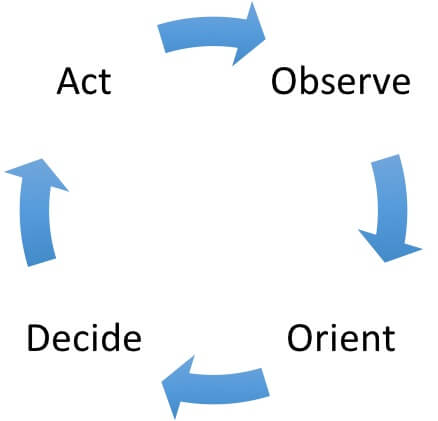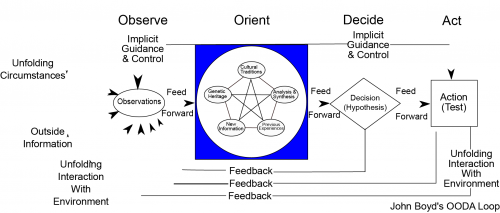Insight Paper November 5, 2015
Advanced Analytics and the Way of the Fighter Pilot
How applying analytics in the right way can help your company outmaneuver the competition
Colonel John Boyd was a steely-eyed fighter ace.
The story goes that following the Korean War, Boyd, a relatively young fighter pilot with few combat engagements to his name boasted that he could beat any combat pilot in an airborne dogfight, from a position of great disadvantage, within 40 seconds – or he’d pay out $40.
Now, fighter pilots are a stereotypically macho bunch, so the challengers came from far and wide. For years, Boyd defeated all comers. Legend holds that he was never defeated. His opponents would start on his 6 o’clock with their “fangs out,” as they say. But without fail, within 40 seconds, they’d be “toast.”
Boyd would perform a maneuver that was so radical and unexpected that the seasoned combat aces challenging him simply could not react. As time proceeded on, most of Boyd’s challengers knew exactly what he was going to do and how he was going to do it. But it was like they were moving in slow motion compared to “40-second Boyd.”
In his later life, John Boyd came up with a theory as to how this worked. He observed that it wasn’t his speed and it wasn’t superior machinery that produced victory; it was rather his ability to out-think and out-maneuver his opponent in a volatile environment. He called this cognitive model of how humans make tactical decisions the OODA Loop. The acronym stands for the phases: Observe-Orient-Decide-Act.
It’s a simple concept: in order to take effective action in the world, one must precisely observe a rapidly changing situation, orient to it, make a decision from available options, take action and then return to observe the results.
But this theory has earned him posthumous praise as the most important military strategist the world has known since Sun Tzu. Here’s why.
Considering the OODA loop as a sequential process, the speed or rate around the loop from Observation to Action can be considered one’s operational tempo. An overly simplistic interpretation is that if you can “out turn” your opponent by compressing the time between stages, several strange things start to happen. It’s like a sustained no-huddle offense. The opposing team literally begins to execute actions that are confused and ineffective. They experience disorientation as they attempt to respond to a situation changing too rapidly.
Cognitively, humans must observe, orient, and decide before we take effective action. If the other side cannot achieve at least orientation before your side’s next action, then this high operational tempo creates a “cognitive fog” of uncertainty for the opponent even if they know your strategy. And the effects, like compounding interest, add up over time. Soon, you’ve not only won the engagement, you’re controlling the battlefield – or the marketplace.

It’s actually far more nuanced than this, though. The OODA loop is not a sequential process; it is a cross-referencing learning process that allows us to thrive in the heat of competition. The depiction below is based on the diagram Boyd actually presented.
But this theory has earned him posthumous praise as the most important military strategist the world has known since Sun Tzu. Here’s why.
Applying the Way of the Fighter Pilot
So how do we apply this model to management and to technology? The engine of victory depicted above has many important lessons to teach us, but three of the simplest are:
- Cultivate a sustainably high operational tempo
- Open to real-time observations about the changing environment
- Challenge the paradigm

Cultivating a Sustainably High Operational Tempo
Operational Tempo is the rate at which one proceeds through the OODA Loop. But it’s not just the rate – it’s how well the loop is executed. A high rate is nothing if decisions and actions do not match reality. When John Boyd executed his confusing aerial maneuver, he was not only trying to turn faster than his opponent, he was deliberately confusing his opponent’s ability to Observe and Orient to the situation – while preserving his own ability to do so. Therefore, Boyd’s actions were coordinated, whereas his opponent’s were confused.
In order to increase our operational tempo in an organization, we must not only compress the time between steps, we must ensure that we are able to rapidly and accurately observe and orient to an ever-changing set of conditions. Otherwise, our team is simply working harder, not better.
In the past, the focus of business technology has been chiefly on using process automation and other methods to increase this tempo by compressing the time between decision and action. But these approaches are now the table stakes; it will take much more than this to be effective in the current competitive environment.
Opening to Real-Time Observations
In any competitive situation, we must take in new information about a changing environment. In simple terms, therefore, more or better information should lead to better decisions and better actions.
We encounter several key problems in the observation phase. There’s often no lack of data about our business environment, but it can be difficult for us to separate the signal from the noise. There’s always a degree of uncertainty, leading us to often use incomplete or inaccurate data in our observations. Finally, the data itself is often quite old; data about the past may not align to the current competitive environment.
For years, companies have been extrapolating observations about their current situation from trailing indicators. We’ve attempted to build enterprise data warehouses to help surface chiefly historical business data in a structured way to enable better and more accurate decision-making, and these efforts can be extremely valuable, but there are several key problems. In order to create an enterprise data warehouse, one must create a structure and a data model given a set of known or likely questions. This often takes a great deal of time. Data must be populated from source systems, usually after it has been processed by other systems such as a claims system or a billing system. Data that does not fit the model is discarded. Finally, one must know how to ask the right questions the right way to get accurate results from the data warehouse.
In Boyd’s model, this enterprise data warehouse can create a powerful support for the “Past Experience” portion of the Orient phase, but it does not create “real-time” observation capability.
Challenging the Paradigm
Humans orient to a given situation through the filter of a mental model, which has a powerful impact on the way we process information. Boyd’s radical aerial maneuvers helped him win every mock engagement for years partly because he broke his opponent’s mental model. His opponent could not orient properly to his action and respond appropriately because the new information about Boyd’s position was thrown out – even though they knew in advance he’d be doing something radical.
In business, we have what are essentially shared mental models. This often works well, but it also means that our brains do not exclusively process new information at every moment in time. In the heat of competition, new information which does not fit the mental model is often discarded. A variety of factors, such as past experience and traditions, contribute to these mental models or paradigms. We are not, in fact, objective and perfect observers.
Usually, paradigms work out pretty well, or they wouldn’t be paradigms. But in certain special circumstances, such as during a disruption cycle, our mental models may not fit reality. As a result, we may not be able to respond appropriately.
In business, disruptions like this can occur as market forces change, or they may be created by competitors with new business models. Great examples of this phenomenon exist throughout the business canon, such as the sad case of Eastman Kodak, which had the first digital camera but failed to understand how it would completely disrupt the film-based marketplace.
In order to address competitive threats and opportunities, we must be constantly challenging our own mental models, tweaking them, and responding to new information. But from a technology perspective, Enterprise Data Warehouses are a crystallization of past mental models which may address the probable futures imaginable at the the time of the model’s creation.
How to Win: Build an Advanced Analytics Capability
So how does a company win in the current business environment? Let’s consider what’s possible against the backdrop of the OODA model.
We can certainly use technology to compress our organization’s operational tempo and increase our efficiency. As technologists, this is what we’ve always done – and so have most of our competitors. We can build an insanely great data model and massage all the important and structured data in our organization to literally fit this model. From there we can derive actionable insights about probable futures and detect many important patterns. Don’t get us wrong – this is the ante.

However, this is a paper about driving competitive advantage. The richest source of competitive advantage for business today is the ability to derive actionable analytics from the fire hose of real-time data available today.
Why is this? Building an advanced analytics capability allows us access to streams of nearly real-time data and allows us to filter the signal from the noise. The mature analytics capability applies a variety of tools to rapidly create and evolve information models based on a continually evolving set of observations, helping organizations make better observations, decisions, and actions.
Leading companies don’t get rid of the Enterprise Data Warehouse. They continue to leverage the gold mine of existing structured and unstructured data. But they do greatly reduce the time from question to answer and they do invest in the capability for real-time and even predictive analytics. This allows these organizations to do two things: first, this compress the OODA loop by improving observation and orientation efficiency; second, it provides greater accuracy of observation because it’s based on real-time data. This enables rapid adaptation to a more clearly understood reality. These organizations become a disruptive force in the marketplace. Their operational tempo increases. They become outwardly focused and data-driven. And the effectiveness of their actions greatly increases. And to their disrupted competitors, it’s like they have access to advanced alien technology.
And like those aces who challenged “40-second Boyd”, their competitors won’t know what hit ‘em.
Summary
In the continually escalating arms race of marketplace competition, companies which implement advanced analytics capabilities will either maintain a technological lead or be disrupted by more advanced upstart competitors. Whether your company is an established leader or a fast-moving disruptor, Trexin has the skills to help you outmaneuver your competition. For more on Trexin’s Analytics capability or to get in touch, please click here.

